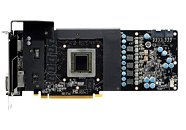Monday, December 16th 2013

MSI Radeon R9 290 Series Gaming PCB Pictured
Here's the first picture of the PCB under the hood of MSI's Radeon R9 290X Gaming OC graphics card, which was unveiled in Japan, over the weekend, and which was detailed in a slightly older article. It turns out that MSI will use the same board design (including the back-plate) on both the R9 290X Gaming OC and the R9 290 Gaming OC, both of which have been put up for pre-order by Canadian e-tailer NCIX. The R9 290X Gaming OC is priced at $699 CAD including taxes (US $660); while the R9 290 Gaming OC is priced at $529.99 CAD including taxes (US $500).
The PCB itself is a slight variation of MSI on AMD's reference design. The layout is identical, but there are subtle differences in component choices MSI made. For example, it ditches Coiltronics-made chokes for MagicTech. Appears to use SK Hynix made memory chips (instead of Elpida on a vast majority of retail R9 290 series boards), etc. It also appears to retain dual-BIOS. According to NCIX, both cards will feature untouched memory clock speeds of 5.00 GHz, yielding memory bandwidth of 320 GB/s, but feature 5-7 percent overclocks on the GPU. The R9 290 Gaming OC features GPU clock speeds (possibly PowerTune boost) of up to 1000 MHz (vs. 948 MHz reference), while the R9 290X Gaming OC features 1040 MHz.
The PCB itself is a slight variation of MSI on AMD's reference design. The layout is identical, but there are subtle differences in component choices MSI made. For example, it ditches Coiltronics-made chokes for MagicTech. Appears to use SK Hynix made memory chips (instead of Elpida on a vast majority of retail R9 290 series boards), etc. It also appears to retain dual-BIOS. According to NCIX, both cards will feature untouched memory clock speeds of 5.00 GHz, yielding memory bandwidth of 320 GB/s, but feature 5-7 percent overclocks on the GPU. The R9 290 Gaming OC features GPU clock speeds (possibly PowerTune boost) of up to 1000 MHz (vs. 948 MHz reference), while the R9 290X Gaming OC features 1040 MHz.

15 Comments on MSI Radeon R9 290 Series Gaming PCB Pictured
Stop teasing, start pleasing.
Love,
happita
Don't use Elpida ram on any 290x models. I find it despicable this is occurring on a premium product. It is a pretty dirty way to save a couple dollars when those chips use more voltage at 6ghz bin (and hence will clock lower at whatever mem voltages amd set obviously planning for use with hynix), and the 'default' 1ghz clock is pretty close to in parity with 5ghz. Obviously overall power consumption is a key factor to these skus and elpida will offset the balance in one way or another (by becoming a bottleneck or using more power hampering clockspeeds).
Good on MSI for Hynix all-around, but Elpida is a ridiculously stupid choice that will bottleneck 290x cards and make them less desirable. It makes sense as differentiators on 290, us cheapskates don't really care, and it shouldn't be a limiting factor in any meaningful degree for that card...but I really think amd should put their foot down on the 290x....
...Unless they plan on shipping an XTX model with 1.35v 5500mhz (essentially newer node 1.5v 7ghz stuff binned for lower power consumption) Hynix memory as a refresh sku, in which case allowing such a setup so a future product will look better (just like 7870 vs 270x) is just plain insulting...especially when review samples (and some aibs) use hynix that can max out the gpu's potential (with slight variances on newer products using less ram voltage) from the start.
AMD needs some tighter design regulations across their whole damn BOM so they have tighter control of what their products are and they want them to be. Be it from caps, vrms, memory, cooler, whatever...It's freaking embarrassing.
I sure hope they will have a normal horizontal heatsinks instead of the vertical one in which the MSI 290x has...... just a wishful thinking